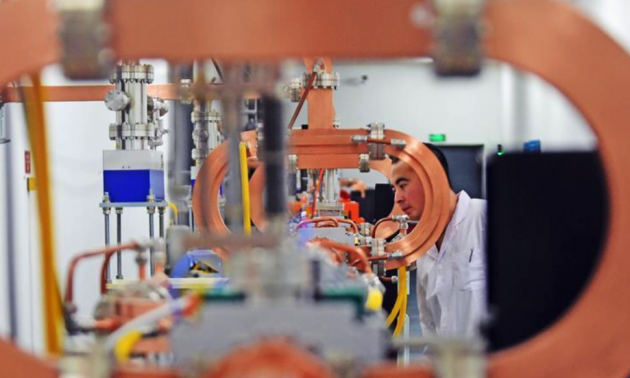

A scientist works on photon source equipment inside a lab at the Chinese Academy of Sciences. Photo: Xinhua
Chinese scientists will start building the world’s brightest synchrotron radiation light source by the end of this year in Beijing to shed new light on the study of microscopic particles.
"How does a blood cell flow in a vessel? How does a scientific device at the nanometer level work? How do we inject and extract lithium ions from batteries? All [such] studies rely on light with extremely short wavelengths, or in other words, extremely bright light," said a researcher in the Institute of Physics of the Chinese Academy of Sciences.
The High Energy Photon Source (HEPS), also called the “Beijing light source,” is expected to produce X-rays of up to 300,000 electronvolts in photon energy, according to the CAS’s Institute of High Energy Physics (IHEP), which oversees the project.
A synchrotron radiation light source emits electromagnetic radiation typically produced by a large storage ring.
To generate light of extreme brilliance, electrons will be accelerated nearly to the speed of light in several stages and forced to travel in a closed path. Bending magnets and insertion devices in the storage ring, with a circumference up to about 1,360 meters, will supply the strong magnetic fields to help convert high-energy electrons into photons with high brilliance, according to the CAS.
Construction of the HEPS will be completed in 2024 and its first phase will cover about 65 hectares in Beijing’s suburban Huairou district, consisting of accelerator chains, beamlines and other auxiliary facilities.
The accelerator chains include a linear accelerator, a booster and a ring to enable more photons of a given direction to be concentrated on a spot to elevate the light’s brilliance.
The X-rays produced by such a powerful light source could help open a new door for observing and studying matter at the micrometer to nanometer level for material science, chemical engineering, biomedicine and other fields, Xinhua reported.
Scientists use different forms of light to study different things. For instance, they observe stars with radio waves, track aircraft with microwaves, and study very small objects, such as viruses, protein molecules and metal atoms with light that is close to the size of these particles in wavelength. (Asia Times)

86-10-68597521 (day)
86-10-68597289 (night)

86-10-68511095 (day)
86-10-68512458 (night)

cas_en@cas.cn

52 Sanlihe Rd., Xicheng District,
Beijing, China (100864)

